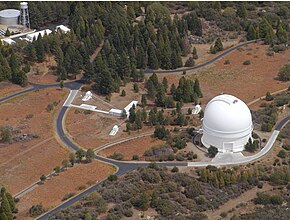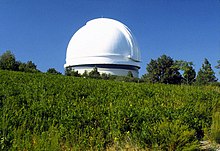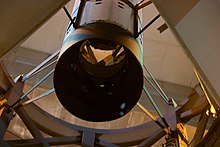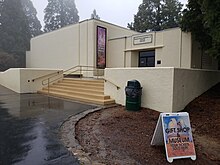Palomar Observatory
 | |
| Alternative names | 675 PA |
|---|---|
| Organization | |
| Observatory code | 675 |
| Location | San Diego County, California |
| Coordinates | 33°21′23″N 116°51′54″W / 33.3564°N 116.865°W |
| Altitude | 1,712 m (5,617 ft) |
| Established | 1928 |
| Website | www |
| Telescopes |
|
| | |
Palomar Observatory is an astronomical observatory located in San Diego County, California, United States, 145 kilometers (90 mi) southeast of Los Angeles, California, in the Palomar Mountain Range. It is owned and operated by the California Institute of Technology (Caltech), located in Pasadena, California. Research time at the observatory is granted to Caltech and its research partners, which include the Jet Propulsion Laboratory (JPL) and Cornell University.[1]
The observatory operates several telescopes, including the 200-inch (5.1 m) Hale Telescope and the 48-inch (1.2 m) Samuel Oschin Telescope. In addition, other instruments and projects have been hosted at the observatory, such as the Palomar Testbed Interferometer and the historic 18-inch (0.46 m) Schmidt telescope, Palomar Observatory's first telescope, dating from 1936.
History

Hale's vision for large telescopes and Palomar Observatory
Astronomer George Ellery Hale, whose vision created the Palomar Observatory, built the world's largest telescope four times in succession.[2] He published an article proposing what was to become the 200-inch Palomar reflector; it was an invitation to the American public to learn about how large telescopes could help answer questions relating to the fundamental nature of the universe. Hale hoped that the American people would understand and support his project even though the country was in the depths of the Great Depression.
Hale followed this article with a letter to the International Education Board (later absorbed into the General Education Board) of the Rockefeller Foundation dated April 16, 1928 in which he requested funding for this project. In his letter, Hale stated:
"No method of advancing science is so productive as the development of new and more powerful instruments and methods of research. A larger telescope would not only furnish the necessary gain in light space-penetration and photographic resolving power, but permit the application of ideas and devices derived chiefly from the recent fundamental advances in physics and chemistry."
Hale Telescope
The 200-inch telescope is named after astronomer and project manager George Ellery Hale. It was built by Caltech with a $6 million grant from the Rockefeller Foundation, using a Pyrex blank manufactured by Corning Glass Works under the direction of George McCauley after several years of unsuccessful attempts by General Electric under Dr. A.L. Ellis. The first steps toward funding the construction of the 200 inch telescope were taken by Hale in 1928 and included a 23-ton glass block cast by José Antonio de Artigas Sanz. Dr. J.A. Anderson was the initial project manager, assigned in the early 1940s.[3] The telescope (the largest in the world at that time) saw first light January 26, 1949 targeting NGC 2261.[4] The American astronomer Edwin Powell Hubble was the first astronomer to use the telescope.
The 200-inch telescope was the largest telescope in the world from 1949 until 1975, when the Russian BTA-6 telescope saw first light. Astronomers using the Hale Telescope have discovered distant objects at the edges of the known universe called quasars and have given us the first direct evidence of stars in distant galaxies. They have studied the structure and chemistry of intergalactic clouds, leading to an understanding of the synthesis of elements in the universe, and have discovered thousands of asteroids. A one-tenth-scale engineering model of the telescope at Corning Community College in Corning, New York, home of the Corning Glass Works (now Corning Incorporated), was used to discover at least one minor planet, 34419 Corning.†
Architecture and design

According to the Observatory's Public Affairs Office, Russell W. Porter was primarily responsible for the Art Deco architecture of the Observatory's buildings, including the dome of the 200-inch Hale Telescope. Porter was also responsible for much of the technical design of the Hale Telescope and Schmidt Cameras, producing a series of cross-section engineering drawings. Porter worked on the designs in collaboration with many engineers and Caltech committee members.[5][6][7]
Max Mason directed the construction and Theodore von Karman was involved in the engineering.
Directors
- Ira Sprague Bowen, 1948–1964
- Horace Welcome Babcock, 1964–1978
- Maarten Schmidt, 1978–1980
- Gerry Neugebauer, 1980–1994
- James Westphal, 1994–1997
- Wallace Leslie William Sargent, 1997–2000
- Richard Ellis, 2000–2006
- Shrinivas Kulkarni, 2006–2018
- Jonas Zmuidzinas, 2018–
Palomar Observatory and light pollution
Much of the surrounding region of Southern California has adopted shielded lighting to reduce the light pollution that would potentially affect the observatory.[8]
Telescopes and instruments


- The 200-inch Hale Telescope was first proposed in 1928 and has been operational since 1948. It was the largest telescope in the world for 45 years.[9]
- A 60-inch reflecting telescope is located in the Oscar Mayer Building. It was dedicated in 1970 to take some of the load off of the Hale Telescope. This telescope was used to discover the first brown dwarf star.[10]
- The 48-inch Samuel Oschin Telescope (Schmidt Camera) was started in 1938 and installed in 1948. It was initially called the 48-inch Schmidt, and was dedicated to Samuel Oschin in 1986.[11] The dwarf planet Eris was discovered using this instrument.[12] The existence of Eris triggered the discussions in the international astronomy community that led to Pluto being re-classified as a dwarf planet.
Former instruments
- An 18-inch Schmidt camera became the first operational telescope at the Palomar in 1936. In the 1930s, Fritz Zwicky, a Caltech astronomer, discovered over 100 supernovae in other galaxies with this telescope and gathered the first evidence for dark matter. Comet Shoemaker-Levy 9 was discovered with this instrument in 1993. It has since been retired and is on display at the small museum/visitor center.[13]
- The Palomar Testbed Interferometer was a multi-telescope instrument that permitted astronomers to make very high resolution measurements of the sizes and positions of objects in space. The shapes of some bright stars were measured with the PTI. It operated from 1995 to 2008.[14]
- The Palomar Planet Search Telescope (PPST), also known as Sleuth, was a 0.1 m (3.9 in) robotic telescope that operated from 2003 until 2008. It was dedicated to the search for planets around other stars using the transit method. It operated in conjunction with telescopes at Lowell Observatory and in the Canary Islands as part of the Trans-Atlantic Exoplanet Survey (TrES).[15]
Research

The observatory has completed several astronomical surveys: the first in the 1950s, the second in the 1980s and 1990s, and a third in 2003.
POSS-I
The initial Palomar Observatory Sky Survey (POSS or POSS-I), sponsored by the National Geographic Institute, was completed in 1958. The first plates were shot in November 1948 and the last in April 1958. This survey was performed using 14 inch2 (6 degree2) blue-sensitive (Kodak 103a-O) and red-sensitive (Kodak 103a-E) photographic plates on the 48-inch Samuel Oschin Schmidt reflecting telescope. The survey covered the sky from a declination of +90 degrees (celestial north pole) to −27 degrees and all right ascensions and had a sensitivity to +22 magnitudes (about 1 million times fainter than the limit of human vision). A southern extension extending the sky coverage of the POSS to −33 degrees declination was shot in 1957–1958. The final POSS I consisted of 937 plate pairs.
Fritz Zwicky was the first astronomer to observe on Palomar Mountain and was the father of the sky survey technique.[16]
Digitized Sky Survey (DSS) produced images which were based on the photographic data developed in the course of POSS-I.[17]
J.B. Whiteoak, an Australian radio astronomer, used the same instrument to broaden this POSS-I data further. Whiteoak's observations extended south to about −45 degrees declination, using the same field centers as the corresponding northern declination zones. Unlike POSS-I, the Whiteoak extension consisted only of red-sensitive (Kodak 103a-E) photographic plates.
POSS-II
The Second Palomar Observatory Sky Survey (POSS II, sometimes Second Palomar Sky Survey) was performed in the 1980s and 1990s and made use of better, faster films and an upgraded telescope. The Oschin Schmidt was given an achromatic corrector and provisions for autoguiding. Images were recorded in three wavelengths: blue (IIIaJ), red (IIIaF) and near infrared (IVN) plates, respectively. Observers on POSS II included C. Brewer, D. Griffiths, W. McKinley, J. Dave Mendenhall, K. Rykoski, Jeffrey L. Phinney and Jean Mueller (who discovered over 100 supernovae by comparing the POSS I and POSS II plates). Mueller also discovered several comets and minor planets during the course of POSS II, and the bright Comet Wilson 1986 was discovered by then graduate student C. Wilson early in the survey.[18]
Until the completion of the Two Micron All Sky Survey (2MASS), POSS II was the most extensive wide-field sky survey. When completed, the Sloan Digital Sky Survey will surpass POSS I and POSS II in depth, although the POSS covers almost 2.5 times more area on the sky.
POSS II also exists in digitized form (i.e., the photographic plates were scanned) as part of the Digitized Sky Survey (DSS).[19]
QUEST
The multi-year POSS projects were followed by the Palomar Quasar Equatorial Survey Team (QUEST) Variability survey.[20] This survey yielded results that were used by several projects, including the Near-Earth Asteroid Tracking project. Another program that used the QUEST results discovered 90377 Sedna on 14 November 2003, and around 40 Kuiper belt objects. Other programs that share the camera are Shri Kulkarni's search for gamma-ray bursts (this takes advantage of the automated telescope's ability to react as soon as a burst is seen and take a series of snapshots of the fading burst), Richard Ellis's search for supernovae to test whether the universe's expansion is accelerating or not, and S. George Djorgovski's quasar search.
The camera for the Palomar QUEST Survey was a mosaic of 112 charge-coupled devices (CCDs) covering the whole (4 degree by 4 degree) field of view of the Schmidt telescope. At the time it was built, it was the largest CCD mosaic used in an astronomical camera. This instrument was used to produce The Big Picture, the largest astronomical photograph ever produced.[21] The Big Picture is on display at Griffith Observatory.
Current research
Current research programs on the 200-inch Hale Telescope cover the range of the observable universe, including studies on near-Earth asteroids, outer solar system planets, Kuiper Belt objects, star formation, exoplanets,[22] gamma-ray bursts, black holes, and quasars.[23]
The 48-inch Samuel Oschin Schmidt Telescope is actively working on a new sky survey, the Zwicky Transient Facility (ZTF).[24]
The 60-inch telescope is used for a variety of projects, including follow-up observations for the Palomar Transient Factory, and is a rapid response telescope for gamma-ray bursts.
Clearest images
In September 2007, a team of astronomers from the United States and Britain released some of the clearest pictures ever taken of the sky. The pictures were obtained through the use of a new hybrid "lucky imaging" and adaptive optics system that sharpens pictures taken from the Palomar Observatory. The resolution attained exceeds that of the Hubble Space Telescope by a factor of two.[25]
Visiting

The Palomar Observatory is an active research facility. However, parts of it are open to the public during the day. Visitors can take self-guided tours of the 200-inch telescope daily from 9 a.m. to 3 p.m. The observatory is open 7 days a week, year round, except for December 24 and 25 and during times of inclement weather. Guided tours of the 200-inch Hale Telescope dome and observing area are available Saturdays and Sundays from April through October. There are a visitor center and a gift shop on the grounds. Behind-the-scenes tours for the public are offered through the community support group, Friends of Palomar Observatory. Periodic tours are also organized by the Reuben H. Fleet Science Center in San Diego.[26] The observatory is located off State Route 76 in northern San Diego County, California, two hours' drive from downtown San Diego and three hours' drive from central Los Angeles ( UCLA, LAX airport ). Those staying at nearby Palomar Campground can visit Palomar Observatory by hiking 2.2 miles (3.5 km) up Observatory Trail.[27]
In popular culture
In Episode 5 of Gunbuster, Palomar Observatory is used by the Earth Space Force to collect space imagery intelligence.
In the October 11 and 12, 1989, Calvin and Hobbes comic strips, Calvin has a dream where Stupendous Man takes the lens from the Palomar Observatory telescope (though really the telescope has a mirror and not a lens) and uses it to destroy his school.[28]
Canadian band The Rheostatics' 1992 release Whale Music features a track entitled "Palomar." The song depicts a man named Palomar on the top of a mount, cleaning his lenses with saline waters, and assembling his kaleidoscope in his lonely observatory. The song presents a visual characterization of a man on a mountain and his relationship with his best friend, a dog.
In 1994, Palomar is mentioned in the first episode of season 2 of The X-Files, "Little Green Men". Fox Mulder refers to Hale's suggestion that an elf[29] crawled through his window and told him to build the observatory.
The band Wellwater Conspiracy's 1997 debut album, Declaration of Conformity, contains an instrumental track entitled "Palomar Observatory." Wellwater Conspiracy singer/drummer Matt Cameron grew up in San Diego near the observatory.
Selected books
- 1983 — Calvino, Italo. Mr. Palomar. Torino: G. Einaudi. ISBN 9788806056797; OCLC 461880054 (in Italian)
- 1987 — Preston, Richard. First Light. New York: Atlantic Monthly Press. ISBN 9780871132000; OCLC 16004290
- 1994 — Florence, Ronald. The Perfect Machine. New York: HarperCollins. ISBN 9780060182052; OCLC 611549937
- 2010 — Brown, Michael E.. How I Killed Pluto and Why It Had It Coming. Spiegel & Grau. ISBN 0-385-53108-7; OCLC 495271396
See also
- California Institute of Technology
- Digitized Sky Survey
- Jet Propulsion Laboratory
- Mount Laguna Observatory
- National Geographic Society – Palomar Observatory Sky Survey
References
- ^ Cornell University, Dept. of Astronomy: Palomar Observatory
- ^ "George Ellery Hale | American astronomer". Encyclopedia Britannica. Retrieved 2020-03-20.
- ^ Hearst Magazines (April 1942). "Super Camera of the Skies". Popular Mechanics. Hearst Magazines. p. 52.
- ^ "60th Anniversary of Hale Telescope," 365 Days of Astronomy (podcast). January 26, 2009.
- ^ June 2014, Elizabeth Howell 20. "Palomar Observatory: Facts & Discoveries". Space.com. Retrieved 2020-04-06.
{{cite web}}: CS1 maint: numeric names: authors list (link) - ^ "Palomar Observatory | observatory, California, United States". Encyclopedia Britannica. Retrieved 2020-04-06.
- ^ "Palomar, After 50 Years". San Diego History Center | San Diego, CA | Our City, Our Story. Retrieved 2020-04-06.
- ^ International Dark-Sky Association Archived 2008-01-01 at the Wayback Machine (IDA): "Sky Glow Effect on Existing Large Telescopes", IDA Info #20.
- ^ "Caltech Astronomy – The 200-inch Hale Telescope". Caltech Astronomy. Retrieved 2014-12-09.
- ^ "Caltech Astronomy – The 60-inch Telescope". Caltech Astronomy. Retrieved 2014-12-09.
- ^ "Caltech Astronomy – Samuel Oschin Telescope". Caltech Astronomy. Retrieved 2014-12-09.
- ^ "Caltech Astronomy – Discoveries from Palomar Observatory's 48-inch Samuel Oschin Telescope". Caltech Astronomy. Retrieved 2014-12-09.
- ^ "Caltech Astronomy – The 18-inch Schmidt Telescope". Caltech Astronomy. Retrieved 2014-12-09.
- ^ "Caltech Astronomy – Palomar Testbed Interferometer (PTI)". Caltech Astronomy. Retrieved 2014-12-09.
- ^ "Caltech Astronomy – Sleuth: The Palomar Planet Finder". Palomar Skies. Retrieved 2014-12-09.
- ^ Caltech did recognize Fritz Zwicky's sky survey pioneering work; however, The Big Picture project failed to recognize his contribution to the sky survey technique in the introductory panel at the Griffith Observatory.
- ^ Minnesota Automated Plate Scanner (MAPS): MAPS catalogue; Mollise, Rod. (2006). The Urban Astronomer's Guide: a Walking tour of the Cosmos for City Sky Watchers, p. 238., p. 238, at Google Books
- ^ Caltech: The Second Palomar Observatory Sky Survey (POSS II) Archived 2009-05-16 at the Wayback Machine
- ^ NASA/Space Telescope Science Institute (STScI).: Multimission Archive at STScI (MAST)
- ^ Caltech press release: "New Sky Survey Begins at Palomar Observatory." July 29, 2003.
- ^ Caltech: "The Big Picture" Archived 2007-02-04 at the Wayback Machine
- ^ JPL: "Planet-Hunting Method Succeeds at Last." May 28, 2009.
- ^ Caltech: Hale Telescope Observing Runs Archived 2012-12-12 at archive.today
- ^ Caltech: Zwicky Transient Facility (ZTF)
- ^ Ghosh, Pallab. "'Clearest' images taken of space," BBC. September 3, 2007; University of Cambridge, Institute of Astronomy, Lucky Imaging website
- ^ Reuben H. Fleet Science Center: Palomar Observatory tour Archived 2003-04-11 at the Wayback Machine
- ^ "Observatory Trail in Cleveland National Forest". hikespeak.com. Hikespeak. Retrieved March 28, 2017.
- ^ [1]
- ^ Biography of George Ellery Hale at scienceworld.wolfram.com
Further reading
- Crawford, David Livingston (1966). The Construction of large telescopes. London, New York: Academic Press. OCLC 1093049
- Mollise, Rod (2006). The Urban Astronomer's Guide: a Walking Tour of the Cosmos for City Sky Watchers. Berlin: Springer. ISBN 9781846282171. ISBN 9781846282171; ISBN 9781846282164 OCLC 299995003
- Watterson, T.V. (1941). Palomar Observatory. San Diego, California: Frye & Smith.OCLC 6327013
External links
- Caltech Astronomy: Palomar Observatory
- Palomar Skies, news and history written by Palomar public affairs coordinator Scott Kardel
- The SBO Palomar Sky Survey Prints
- Palomar Observatory Clear Sky Clock Forecast of observing conditions.

